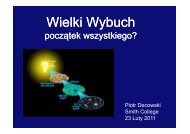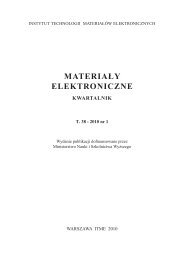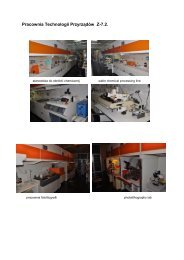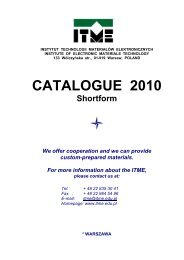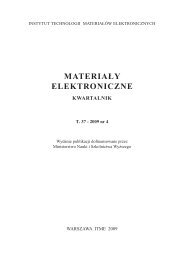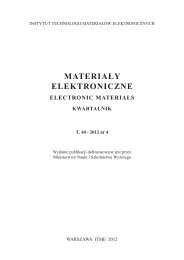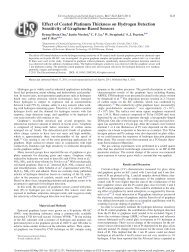MATERIAÅY ELEKTRONICZNE - ITME
MATERIAÅY ELEKTRONICZNE - ITME
MATERIAÅY ELEKTRONICZNE - ITME
Create successful ePaper yourself
Turn your PDF publications into a flip-book with our unique Google optimized e-Paper software.
K. Orliński<br />
MULTIFUNCIONALITY OF MULTIFERROIC-BASED<br />
EUTECTIC COMPOSITES<br />
Krzysztof Orliński<br />
Institue of Electronic Materials Technology, ul. Wólczyńska 133, 01-919 Warszawa<br />
e-mail: krzysztof.orlinski@itme.edu.pl<br />
Present work is dedicated to functional description of eutectic<br />
composites containing rare earth ferrite – REFeO 3<br />
. Materials<br />
that fall under this cathegory exhibit spontaneous dielectric<br />
and magnetic polarization – they behave as ferroelectrics<br />
and ferromagnets and can be “tuned” by small additions of<br />
other rare earth elements without causing large crystal lattice<br />
distortions. Special attention was payed to multifunctionality<br />
that, in majority, comes from the control of the structural refinement<br />
with the supercooling of the crystallizing liquid.<br />
Key words: composite, eutectic, multiferroic, ferromagnetism,<br />
ferroelectric, perovskite, catalyst, green, energy<br />
„Wielofunkcjonalność w kompozytach<br />
eutektycznych na osnowie multiferroicznej”<br />
Niniejsza praca poświęcona jest opisowi funkcjonalności<br />
eutektycznych kompozytów na osnowie ferrytów metali ziem<br />
rzadkich – REFeO 3<br />
. Materiały należące do tej grupy wykazują<br />
jednocześnie spontaniczną polaryzację dielektryczną<br />
(ferroelektryczność) i magnetyczną (ferromagnetyzm) a ponadto<br />
dają się „stroić” za pomocą domieszek innych metali<br />
ziem rzadkich nie powodując silnych zniekształceń sieci<br />
krystalicznej. Szczególną uwagę zwrócono na wielofunkcjonalność<br />
wynikającą w dużej mierze z możliwości sterowania<br />
rozdrobnieniem struktury za pomocą zmiany przechłodzenia<br />
krystalizującej cieczy.<br />
słowa kluczowe: kompozyt, eutektyka, multiferroik, ferromagnetyzm,<br />
ferroelektryczność, perowskit, katalizator,<br />
energia, zielona<br />
1. INTRODUCTION<br />
During recent years we witnessed emerging of<br />
a variety of faster and more efficient optoelectronic<br />
and photonic elements. The introduction of optical<br />
fibres was but one of those improvements that made<br />
information transfer faster and more efficient. The<br />
next step, leading to substitution of electricity with<br />
light is far more complex and cannot be achieved<br />
without special materials. As photons are quanta of<br />
electromagnetic waves, both: electric and magnetic<br />
force is needed to influence their trajectory. A branch<br />
of photonic composite materials called metamaterials<br />
is dedicated to demonstration of special properties,<br />
not found in nature, such as negative refraction [1<br />
- 2] or invisibility in certain wavelength spectrum<br />
– “cloaking” [3 - 4].<br />
Moreover, along with the technology standards,<br />
the needs for energy have grown and we found ourselves<br />
in necessity of finding its novel sources, as<br />
well as increasing the efficiency of existing ones. As<br />
the production of large amounts of energy, usually<br />
follows the release of greenhouse gases: carbon,<br />
nitrogen and sulfur oxides, the demand for better<br />
low-cost catalysts of combustion processes is very<br />
high as well. Thus, along with materials for low-cost<br />
catalysis 5 much effort is being put into green energy<br />
sources (solid oxide fuel cells [6 - 8] , photovoltaics)<br />
and environmental monitoring (chemical sensing<br />
[9 - 10], air purification [11 - 12]).<br />
To rise to that challenge, the materials of 21 st<br />
century should possess all, or at least most of those<br />
properties. I would like to focus on how to achieve<br />
such multifunctionality by using simple rules of<br />
material science and physics. Such distinct set of<br />
properties was found in a group of materials called<br />
multiferroics.<br />
2. MULTIFERROICS<br />
Materials, which exhibit both: ferroelectric and<br />
ferromagnetic behaviour are called multiferroics.<br />
Those materials crystallize typically in two types<br />
of structures: perovskite and spinel. The spinel<br />
structure, although described by cubic symmetry, is<br />
very complex and as such, will not be the subject<br />
of further discussion. Instead, the crystal group of<br />
perovskite compounds shall be introduced.<br />
The amount of charge stored inside the material<br />
is highly dependent on the dielectric permittivity and<br />
is found to be the highest in a group called ferroelectrics.<br />
Similarly to ferromagnetics, these materials<br />
show spontaneous polarization of dipoles in certain<br />
direction. Oxide perovskites (Fig. 1) are materials<br />
which very often exhibit ferroelectric behaviour.<br />
35




